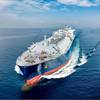Scania’s New 1,000 hp V8 Engine Launched
Continuing the success of Scania’s new global engine platform, enters the latest 16-liter marine V8, delivering up to 1,000 hp and 2,460 Ib/ft for patrol craft applications.
While passing this new threshold, the new V8 builds on a long tradition of amazingly compact power packs that shares both technology and architecture with Scania's truck and bus engines. The high power-to-weight ratio of Scania's engines makes for easy installation and exceptional performance. The new 16-liter is the next element to the Scania marine engine solution.
The official North American launch is at the International Workboat Show in New Orleans, LA, December 5-7. Scania USA is showcasing the new 16 and 13-liter engines, as well as the enhanced instrumentation. Besides the new 16-liter V8, Scania’s marine engine range also comprises of a 13-liter inline six-cylinder unit launched in 2011. Intended for propulsion and auxiliary use, the engines are all based on Scania's new state-of-the-art modular engine platform.
Engine-by-engine, the new range has been designed for higher strength and durability. Swept volumes have slightly increased and performance has been boosted. Many components are shared across the range, a factor that facilitated parts supply, since it significantly reduces the number of unique parts for used each engine. The modular architecture and common work methods simplify training in Scania’s service network, while maximizing uptime for users. Scania secures control of all strategic steps in development and performance control. Basic engine development and manufacturing, as well as the development of engine management, fuel injection and emission control systems are all carried out in-house. This strategy is motivated by performance and fuel economy demands and targets, as well as by the need to secure consistent environmental performance, robustness and convenience of operation.
16-liter V8s from 550 to 1,000 hp
Important features for the marine engine segment are reliability, high uptime, generous torque at low revs, good fuel economy and prompt engine response. The output of the new 16-liter marine engines spans from 550 hp for continuous use to 1,000 hp for patrol craft use. The ratings have been uprated for planning and displacement vessles and Scania’s engines are highly competitive with engines well above 16-liters.
The torque ratings of up to 2,463.5 lb/ft are particularly high for this output class. This ensures ample performance even at low revs, while facilitating running at favorable revs in all conditions, including high sea and high load. Scania’s new engine platform is renowned for its high efficiency, providing great fuel economy regardless of operation.
Compact V8 power pack
Vital for marine installations is that the engine is compact, has easy-to-fit auxiliaries and is designed for easy servicing. Scania's V8 engines traditionally meet all of these requirements thanks to the compact vee-design, which reduces the overall length.
Each cylinder has its own head, and together with wet cylinder liners, it makes for easy overhauls in confined spaces. Additionally, the camshaft is located high in the block and the timing gears are rear-mounted. For these reasons, most repairs and servicing can be carried out by a single service technician. The Scania Saver ring, placed at the top of each cylinder liner, reduces carbon deposits on the edge of the piston crown and reduces cylinder liner wear.
Extended maintenance intervals
Scania's familiar centrifugal oil cleaner effectively removes small particles from the lubrication oil, while reducing the size of the replaceable filter cartridge. In spite of higher performance and tighter emission levels, Scania has been able to raise maintenance and oil-change intervals to 500 hours.
Instrumentation optional
Scania has also developed an instrumentation for its marine engines that is easy to install. Via a user-friendly and flexible web interface, the marine operator can adapt the information on the panels and choose any required data to be displayed. The panels have prepared layouts for water temperature, engine speed, oil pressure and fuel consumption. The operator can also connect and configure a gauge indicator for transmission monitoring and for fuel or fresh-water levels. The instrumentation is type approved by the DNV classification society.
Key characteristics of Scania's marine engine range
- Compliance with emission standards IMO II, EU Stage IIIA and US Tier 2
- Scania PDE unit injector fuel injection
- Revised bore and stroke for increased swept volume
- Increased combustion pressure
- Traditional easy-to-service Scania architecture with individual cylinder heads
- Scania engine management
- Saver ring at the top of the cylinder liners to prevent coke build-up on the piston













